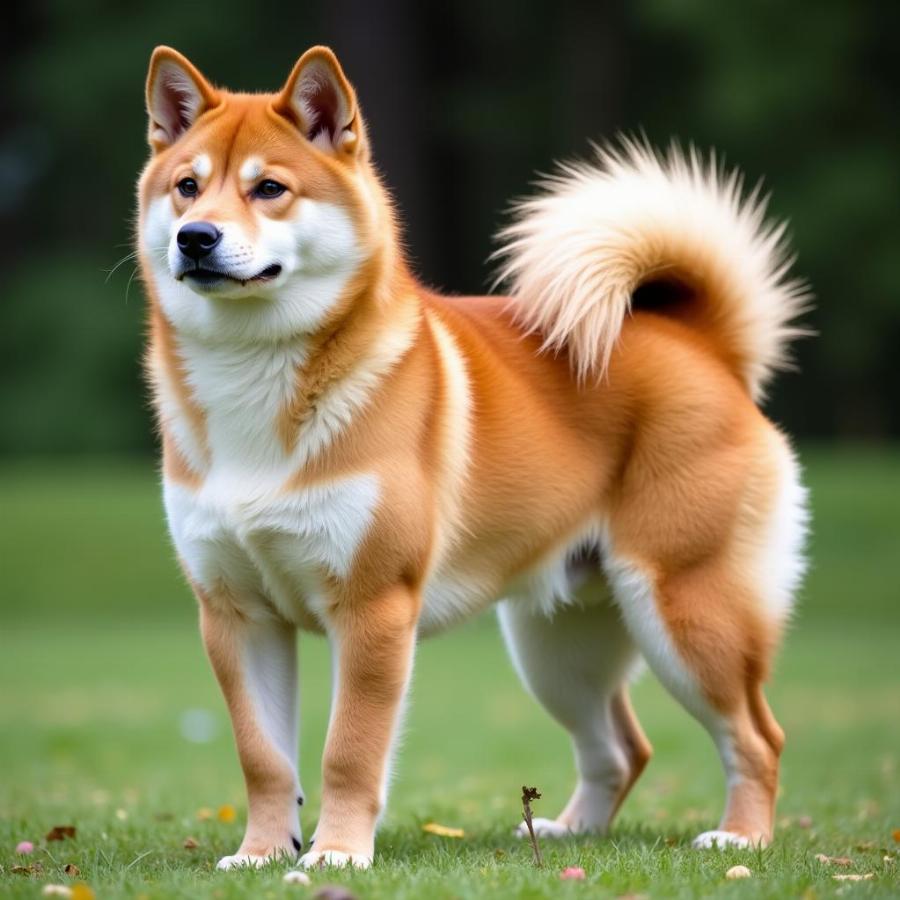The captivating curl of a dog’s tail is a feature that often sparks curiosity and admiration. What breeds boast this distinctive trait? Is it a sign of anything specific about the dog’s personality or health? This article delves into the fascinating world of curly tail dogs, exploring the genetics, breed specifics, and care considerations surrounding this endearing characteristic. We’ll uncover everything you need to know about curly tail dogs, from common misconceptions to practical tips for their well-being.
Understanding the Curly Tail Genetics
The curl of a dog’s tail is primarily determined by genetics. While specific genes responsible for the curl haven’t been definitively isolated in all breeds, it’s generally understood to be a dominant trait. This means that if one parent carries the gene for a curly tail, there’s a high probability the offspring will inherit it. However, the tightness of the curl can vary greatly, even within the same breed, ranging from a gentle curve to a tight, almost circular loop. Sometimes, the curl might be so tight that it touches the dog’s back.
 Shiba Inu with a curly tail
Shiba Inu with a curly tail
Curly Tail Dog Breeds: A Closer Look
Several breeds are known for their curly tails, each with its unique characteristics and charm. Some of the most prominent curly tail dog breeds include Shiba Inus, Akitas, Chow Chows, Finnish Spitz, and Norwegian Buhunds. While the Shiba Inu’s tail is often described as a “sickle tail” due to its curved shape, other breeds like the Pug sport a tighter curl often referred to as a “double curl.” Let’s take a closer look at a few of these breeds:
-
Shiba Inu: This Japanese breed is renowned for its fox-like appearance and spirited personality. curly tailed japanese dog are particularly striking.
-
Pug: These charming little dogs with their wrinkled faces and curled tails are known for their playful and affectionate nature.
-
Finnish Spitz: This energetic breed is known for its distinctive curled tail that often rests over its back.
Is a Curly Tail a Sign of Health Issues?
While a naturally curled tail is a defining characteristic of certain breeds, in some cases, it can indicate an underlying health issue. A suddenly curled tail in a dog that previously had a straight tail can be a sign of an injury or neurological problem. It’s crucial to consult a veterinarian if you notice any sudden changes in your dog’s tail carriage.
Caring for Your Curly Tail Dog
Caring for a curly tail dog doesn’t differ significantly from caring for other breeds, but there are a few things to keep in mind. Ensure their diet supports a healthy coat and skin, as this contributes to the overall appearance of their tail. Regular grooming is also essential, especially for breeds with thick double coats like the Chow Chow.
“A healthy diet and regular grooming are crucial for maintaining the beauty and health of a curly-tailed dog,” says Dr. Emily Carter, DVM, a renowned veterinarian specializing in canine health. “Paying attention to these details can significantly contribute to their overall well-being.”
What Does a Dog’s Tail Tell Us?
A dog’s tail is a powerful communication tool, and even the curl can subtly influence its expression. While the primary signals come from the tail’s movement and position, the curl can add nuance to these expressions. dogs that have curly tails often exhibit a unique charm in their tail wags.
Conclusion
The curly tail is a fascinating and endearing trait in many dog breeds. Understanding the genetics and breed-specific nuances of this characteristic can help you appreciate the unique charm of your curly tail dog. By providing proper care and attention, you can ensure your furry friend remains healthy and happy, flaunting their beautiful curled tail with pride. curly tail dogs bring a unique joy to their owners, and understanding their unique traits can enhance the bond between human and canine companions.
FAQ
- Are all curly tail dogs purebred? Not necessarily. The curly tail gene can appear in mixed breeds as well.
- Do curly tails require special grooming? Not particularly, but regular grooming is important for overall coat health.
- Can a straight-tailed dog develop a curly tail? While rare, this can happen due to injury or medical conditions. Consult a vet if you notice any sudden changes.
- Are curly tail dogs more prone to any specific health issues? No, the curly tail itself doesn’t indicate any specific health predisposition.
- What’s the difference between a sickle tail and a double curl? A sickle tail is a gentle curve, while a double curl forms a tight loop.
- Are curly tail dogs more playful? Not necessarily. Temperament depends on breed and individual personality.
- Can I predict if my puppies will have curly tails? If one parent has a curly tail, the chances are higher, but it’s not always guaranteed.
“Observing the subtle nuances of a dog’s tail, including the curl, can provide valuable insights into their emotional state,” shares Dr. Michael Davies, a certified canine behaviorist. “It’s a fascinating aspect of canine communication.”
Beaut Dogs is your go-to resource for all things related to dog breeds and care. We offer comprehensive information and expert advice to help you navigate the wonderful world of dog ownership. For further assistance, please contact us at Email: [email protected] to receive detailed and accurate answers from Beaut Dogs. dog with curly tail are just one of the many fascinating topics we cover.